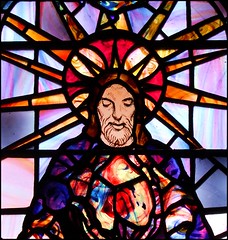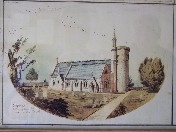| |
|
St
Michael, Geldeston
 |
|
The
lanes of the parishes of Geldeston, Ellingham and
Kirby Cane intertwine lazily across the Waveney
meadows to the north of Bungay and Beccles.
Unusually for this part of Norfolk, the parishes
keep their churches locked, which is unfortunate,
but all three have keyholder notices. St Michael
is set pleasingly on the side of a hill, which
rises to the east beyond the church. Here, there
is a sombre war memorial decorated with the
crests of various regiments, and a good crop of
18th and 19th century inscriptions among the wild
grasses. I liked it a lot. The
exterior is crisp, thanks to two extensive
restorations. In the 1860s, the chancel was
rebuilt and a rather disproportionate north
transept added to the designs of Thomas Penrice
and JL Clemence. And then in the 1880s the tower
was remodelled, at the expense of the Rector:
fortunately perhaps, he ran out of money, for the
architect's watercolour on display in the porch
shows a planned moorish minaret which was never
built.
Otherwise,
this is a small Norman church, one of many in the
Waveney Valley, with the important exception that
there is a fine late medieval porch on the south
side, with crisply carved emblems of the Holy
Trinity and Instruments of the Passion in the
spandrels.
|
The church
is a little gloomy inside, as befits the period of its
restoration, but the eye is led to the east, and one of
Norfolk's more important 1950s windows. It is by Leonard
Walker, and depicts the Risen Christ. It is similar to
the same subject at East Tuddenham except that, unusually
for the period, the elements are set in stretched, tinted
glass.
The
mock-Early English double entrance to the transept is
alarming, but the view westwards is of a typical rural
parish church. The late 15th Century font is fairly
typical too, except that it has an exceptionally clear
dedicatory inscription to William Garneys and his wife.
Interestingly, the designs on the panels repeat the Holy
Trinity and Instruments of the Passion motifs from the
porch - was William Garneys responsible for the porch as
well?
| Dan
Gillett, the Rector at the time of the 1860s
work, has left a deep cut inscription at the
entrance to the new vestry to ensure that his
part was not forgotten. And there are other
people remembered at Geldeston too. Robert
Christopher Packe died in 1918, at sea, while on
patrol duty off of Great Yarmouth. He was just 19
years old. Is his memorial the only one in East
Anglia which records a birth in the Falkland
Islands? Not far off is a very similar memorial
to Henry Latham Kerritch. The Kerritches lived at
Geldeston Hall, and Henry was mortally
wounded in the assault on Passchendaele Ridge,
September 26th 1917. He was 21 years old. An elegant
inscription in a window records the sad fate of
two of Henry Latham Kerritch's nephews, two
brothers, in the next War. Hugh Richard Kerritch
failed to return from Dunkirk in 1940, while John
Arthur Kerritch died in Malaya in 1941. Both were
in their early twenties. Just four of many
Geldeston lads who failed to come back to this
lovely rural parish.
|
|
 |
|
|
|
